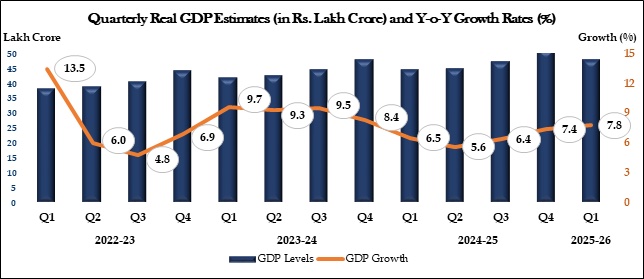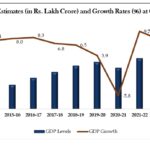India’s economy clocked a five-quarter high growth of 7.8 per cent in the April–June period (Q1 FY26), powered by resilient domestic demand and robust government spending. But economists warn the impressive print may mask looming headwinds, particularly the full impact of punitive U.S. tariffs that threaten to dampen exports and investment in the coming quarters.
According to the National Statistics Office, real GDP at constant 2011–12 prices stood at ₹47.9 lakh crore ($578 billion) in Q1 FY26, up from ₹44.4 lakh crore ($535 billion) a year earlier. Gross fixed capital formation (GFCF) rose 7.8 per cent year-on-year, while private consumption expanded 7 per cent and government consumption 7.4 per cent.
Tariffs cloud the horizon
Upasna Bhardwaj, Chief Economist at Kotak Mahindra Bank, said while the stronger-than-expected numbers provided “a reasonable upside” to her earlier full-year growth forecast of 6.2 per cent, the outlook is clouded by tariff risks. “We remain fairly cautious on the way ahead amid expected slowdown in exports from higher tariffs along with deferring in production ahead of GST rate cuts,” she said. “We expect some policy interventions to help offset the adverse impact of the tariff impact on exporters.”
The caution is widely shared. Joe Maher of Capital Economics noted that while the economy looks in “rude health” after its stellar Q1, the direct impact of a 50% tariff imposed by the U.S. this month has yet to filter into the data. “Ordinarily we’d be inclined to revise up our full-year forecast. But the economy faces stiffer headwinds,” he said. “Growth will now slow, though GST cuts and a weaker rupee will cushion the blow.”
Broad-based growth in Q1
The strength of the Q1 print lay in its breadth. Manufacturing expanded 7.7 per cent on the back of healthy corporate profits, construction grew 7.6 per cent on the support of government spending and housing demand, and services surged 9.3 per cent, the fastest in two years. Agriculture too recovered to 3.7 per cent on the back of a good rabi harvest and early monsoon rains.
Madan Sabnavis, Chief Economist at Bank of Baroda, called the performance “beyond expectations,” with growth spearheaded across manufacturing, construction, and services. But he flagged that much of the momentum was flattered by unusually low-price deflators. “Nominal growth was just 8.8 per cent which, when juxtaposed with negative inflation numbers, works its way to the real GDP growth,” he explained.
While both consumption and investment expanded at healthy rates in nominal terms, Sabnavis said the effect of tariffs could shave off 0.2–0.4 percentage points from annual growth. “The economy does look poised to clock 6.5 per cent for the year notwithstanding tariff effects, but the low-price deflator effect would also help in supporting the growth number,” he said.
Consumption tailwinds, but risks ahead
For now, consumption appears resilient. Deloitte’s Rumki Majumdar pointed to income tax cuts and lower inflation bolstering household spending. “Evidently, the income tax exemptions that came into effect this fiscal year have started boosting disposable incomes and discretionary spending,” she said, citing robust retail sales growth and FMCG expansion.
Yet, as ICRA’s Aditi Nayar cautioned, discretionary purchases could be deferred until GST rate cuts kick in later this year, and potential job losses in export-linked sectors could sour sentiment. “After the unexpectedly strong Q1 FY26, a lower year-on-year momentum of government capex and the looming hit to exports from the U.S. tariff would dampen growth prints in the coming quarters,” she said, maintaining ICRA’s FY26 growth forecast at 6 per cent.
Investment-led resilience may be tested
Much of the Q1 momentum was investment-led. Government capex reached nearly a quarter of its annual budgeted target in just three months, up sharply from 16.3 per cent in the same period last year. That translates to ₹2.9 lakh crore ($35 billion) spent in Q1 against the full-year allocation of ₹11.1 lakh crore ($134 billion).
Paras Jasrai of India Ratings & Research noted that this frontloading “helped in propelling investment demand in Q1,” alongside a rebound in private sector capital goods output. But he warned that sustaining the momentum is critical in the face of global turbulence and tariff shocks.
The sustainability question
India’s growth has surprised on the upside, driven by policy stimulus, consumption tailwinds, and frontloaded investment. But the sustainability of this momentum is far from assured. With export-oriented sectors bracing for tariff shocks, corporate production plans adjusting to expected GST cuts, and nominal growth running below 9 per cent, the second half of FY26 could see moderation.
As Bhardwaj put it: “The sharply higher Q1 numbers give comfort, but sustaining this trajectory will require deft policy interventions to cushion exporters and maintain capex momentum.”
(Using ₹83 = $1 for consistency with current rates).






